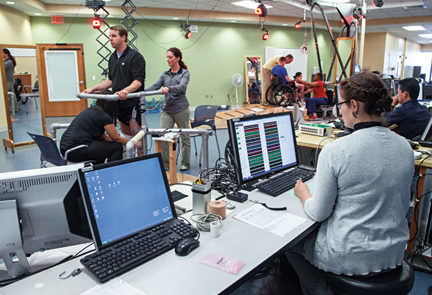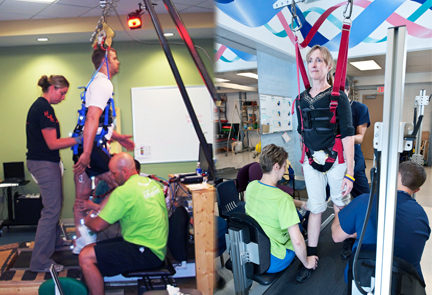
Motor Control Studies
Spinal Epidural Electrode Array to Facilitate Standing and Stepping After Spinal Cord InjuryThis research grant has been completed. The major goal of this research was to investigate the combined effects of stand and step (locomotor) training with electrical stimulation of the spinal cord in individuals who have had a complete SCI. Funding: National Institute of Health ENROLLMENT STATUS: Closed to Recruitment Resulting Publications Harkema, S., Gerasimenko, Y., Hodes, J., Burdick, J., Angeli, C., Chen, Y., Ferreira, C., Willhite, A., Rejc, E., Grossman, R.G. & Edgerton, V. R. (2011). Effect of epidural stimulation of the lumbosacral spinal cord on voluntary movement, standing, and assisted stepping after motor complete paraplegia: a case study. Lancet 377(9781):1938-1947. Sayenko, D. G., Angeli, C., Harkema, S. J., Edgerton, V. R., & Gerasimenko, Y. P. (2014). Neuromodulation of evoked muscle potentials induced by epidural spinal-cord stimulation in paralyzed individuals. J Neurophysiol 111(5):1088-1099. Angeli, C. A., Edgerton, V. R., Gerasimenko, Y. P., & Harkema, S. J. (2014). Altering spinal cord excitability enables voluntary movements after chronic complete paralysis in humans. Brain 137(5):1394-1409. Rejc, E., Angeli, C., & Harkema, S. (2015). Effects of Lumbosacral Spinal Cord Epidural Stimulation for Standing after Chronic Complete Paralysis in Humans. PloS ONE 10(7):e0133998.
Task and physiological specific stimulation for recovery of function after severe spinal cord injuryThe purpose of this study is to evaluate the effects of epidural stimulation of the spinal cord and task specific training on motor control, cardiovascular and respiratory function, and bowel, bladder and sexual function in individuals with spinal cord injury. Funding: Christopher & Dana Reeve Foundation and Helmsley Charitable Trust ENROLLMENT STATUS: Currently Recruiting and Enrolling Cardiovascular and Respiratory Studies
Cardiovascular Recovery with Epidural StimulationThe major goal of this research is to demonstrate that epidural stimulation (ES) can be used to recover significant levels of autonomic control of cardiovascular and respiratory function as well as the ability to voluntarily control leg movements below the injury level. Funding: The Craig H. Neilsen Foundation ENROLLMENT STATUS: Closed to Recruitment Bladder, Bowel and Sexual Function Studies
Effects of Activity Dependent Plasticity on Recovery of Bladder and Sexual Function After Spinal Cord InjuryThe major goal of this research is to promote the recovery of urogenital function through the use of effective rehabilitative strategies alone as well as in combination with epidural stimulation. This work will help increase our understanding of how the lumbosacral spinal networks responsible for walking and standing also interact with the circuitry controlling bladder and sexual function after injury. The importance and ultimate impact of this research is to improve treatment options and enhance quality of life, as bladder and sexual dysfunction consistently rank as top disorders affecting health and well-being after SCI. Funding: National Institute of Health ENROLLMENT STATUS: Currently Recruiting and Enrolling Functional mapping with lumbosacral epidural stimulation for restoration of bladder function after spinal cord injuryThe Goal of the preliminary data from this study was to determine if an effective electrode configuration and stimulation parameter(s) could be achieved with spinal cord epidural stimulation to promote more efficient emptying of the urinary bladder in persons having a motor complete spinal cord injury. Mapping for bladder function with different electrode configurations during repeated filling of the bladder revealed increases in the efficiency of the reflexive void with values within recommended clinical guidelines. The same epidural electrode combination was then tested in four more individuals with spinal cord injury and all showed improvements in bladder emptying as well. Going forward this study will test specific epidural stimulation configurations and then train the participant while using those configurations in a laboratory setting. Funding: SPARC ENROLLMENT STATUS: Currently Recruiting and Enrolling Prospective Randomized Efficacy Study
Task and physiological specific stimulation for recovery of autonomic function, voluntary movement and standing using epidural stimulation and training after spinal cord injury.The primary goal of this research is to answer the following questions:
Funding: Christopher & Dana Reeve Foundation ENROLLMENT STATUS: Currently Recruiting and Enrolling |
|




